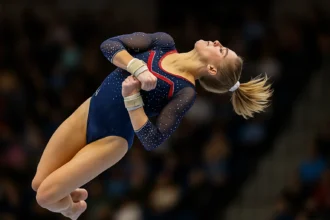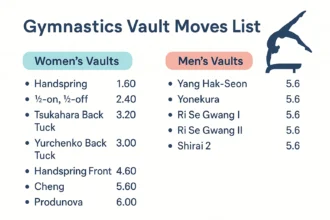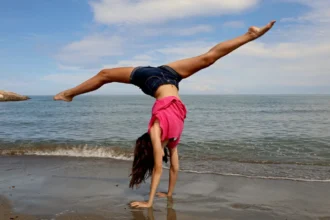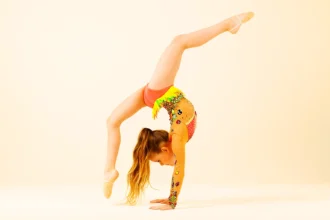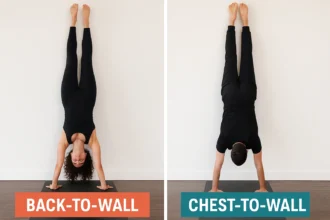The Thomas Salto is a distinctive gymnastics move named after American gymnast Kurt Thomas, who introduced it during the 1978 World Championships in Strasbourg, France. Kurt Thomas became the first American male gymnast to win a gold medal at the World Championships, securing the top spot in the floor exercise event.
The Thomas Salto was a groundbreaking skill, known for its difficulty, originality, and risk. This move involves a 1½ backward somersault (salto) with 1½ twists, executed in a tucked or piked position, and landing in a forward roll. Its complexity and originality have made it a notable contribution to the sport.
Technical Breakdown
The Thomas Salto is one of the most innovative and challenging gymnastics elements ever performed, and its difficulty stems primarily from the combination of two distinct phases. Here’s a more detailed look at each phrase:
First Phase: Tucked Backward Salto with 3/2 Twists
1. Initial Jump: The gymnast begins with an explosive jump, generating enough height to complete both the backward salto and the subsequent twist. The height and speed of the jump are crucial, as the gymnast needs sufficient time in the air to execute both rotations precisely.
2. Tucked Position: Once airborne, the gymnast pulls their knees tightly into their chest, adopting a tucked position. This compact shape increases rotational speed and is essential for completing the salto quickly. The more tightly the gymnast tucks, the faster the rotation.
3. Twisting Motion: As the gymnast flips backward, they initiate the 1½ twist. This twist begins almost immediately after the backflip starts to ensure the gymnast completes 1½ rotations before landing. The twisting motion must be controlled and precise to avoid incomplete rotations or loss of orientation in the air.
4. Rotation Control: The gymnast uses their core and shoulders to maintain control over the speed and angle of the twist. The critical challenge is to perform both the salto and twist simultaneously while maintaining a tight and controlled tuck. The gymnast must complete the twist before transitioning into the second phase.
Second Phase: Forward Tucked Roll-Out
1. Transition from Backward to Forward: The most challenging aspect of the Thomas Salto is the transition from the backward rotation to the forward motion of the roll-out. Gymnasts must counteract the backward momentum of the salto while maintaining a controlled body position.
2. Roll-Out Execution: Upon nearing the ground, the gymnast lands on their hands and immediately initiates a forward roll. To perform this, the gymnast must stay in a tucked position, ensuring the body rolls over smoothly. The arms and shoulders guide the gymnast’s body through the roll as they push off from their hands to transition into a forward roll.
3. Precision of the Exit: The final part of the roll-out is critical, as the gymnast must finish with a controlled and clean exit, typically landing on their feet or in a standing position. Over-rotating or losing control during this phase can result in a chaotic finish, leading to deductions or even injury.
Why the “Roll-Out” is So Challenging:
The roll-out is considered the most technically difficult part of the Thomas Salto due to the precise timing and execution required. After completing a complex twist in the air, the gymnast must smoothly flip from a backward rotation into a forward roll, overcoming the backward momentum while maintaining full control. The power and speed generated during the twist add to the complexity of this already challenging maneuver.
Successful execution of the Thomas Salto demands:
- Incredible Core Strength: To stabilize the body during the transition from twist to roll.
- Spatial Awareness: To gauge where the body is positioned in space after the twist, ensuring a seamless roll-out.
- Perfect Timing: To initiate the roll-out at the exact moment after completing the twist, controlling its speed and direction.
The difficulty of the Thomas Salto is heightened by its unique combination of two highly complex moves — the somersault and twist — followed by the need for a precise forward roll to complete the element.
Why The Thomas Salto Is a High-Risk Move
The Thomas Salto was considered a game-changer, pushing gymnasts to perform at an elite level. However, it also posed significant risks. A miscalculation at any phase could result in serious injury.
1. High-Impact Landings:
The Thomas Salto required gymnasts to execute a high-speed, high-impact landing.
The risk of ankle, knee, and lower back injuries was substantial, as the gymnast had to absorb a significant amount of force upon landing. The twisting form combined with the somersault made spotting the landing difficult, particularly when the move was performed on the vault.
2. Neck and Spine Injuries
One of the most dangerous aspects of the Thomas Salto is the risk of over-rotation or under-rotation.
If a gymnast doesn’t generate enough height or twists too much, they risk landing poorly, which can lead to severe injuries to the neck or spine. This was especially concerning for female athletes, whose bodies were not always developed to handle such intense twisting movements.
A notable incident occurred in 1980 when Soviet gymnast Elena Mukhina attempted the Thomas Salto and tragically suffered a catastrophic neck injury that resulted in paralysis, bringing further attention to the dangers of the move.
3. Unacceptable Difficulty Curve
The Thomas Salto raised the difficulty bar to such an extent that it was not attainable for all gymnasts, regardless of their level.
Moves like this could disrupt the natural progression of a gymnast’s development, leading to greater risk of injury at the developmental stage. This prompted gymnastics bodies to standardize difficulty levels to ensure safer progression for athletes.
Why was The Thomas Salto Banned?
The Thomas Salto’s risks, especially following several high-profile injuries, led gymnastics governing bodies to reconsider its safety.
Initially, the move was banned in women’s gymnastics due to the unique physiological challenges posed to female athletes, particularly at the elite level. However, due to ongoing safety concerns and incidents involving male gymnasts, the move was eventually banned in men’s gymnastics as well.
The 2017–2020 Code of Points explicitly prohibited “3/2 salto elements with reception by and then spring from the hands,” effectively banning the Thomas Salto for all gymnasts.
The Impact of the Ban on Gymnastics
The ban on high-risk skills has prompted gymnasts to innovate within the established safety parameters. Athletes and coaches are now focusing on:
- Enhancing existing skills to increase difficulty and artistry.
- Developing new combinations that maintain high difficulty without compromising safety.
- Emphasizing execution quality, as precision and form are crucial for scoring.
This shift has led to more dynamic and creative routines, showcasing the gymnasts’ technical prowess and artistic expression within a safer framework.







